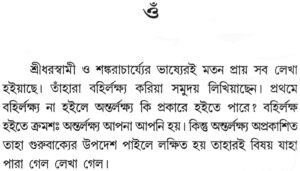Extremely Important Contributions of Lahiri Mahasay to the Scriptural Interpretations From the Inner Realization (Antarlakshya) Point of View
Lahiri Mahasay wrote the following comment about the interpretations of the Bhagavad Gita in Bengali:
“Almost all have written interpretations [on the Bhagavad Gita] as famous commentators like Sridhar Swami and Sankaracharya. They have written [commentaries on the Bhagavad Gita] with the ‘external viewpoint’ [outward attention – the intellectual way].
Respecting others he said, “How could there be inward attention (Antarlakshya) if, ‘at first’, there was no outward attention (Bahirlakshya)?
“From outward attention (Bahirlakshya), gradually and automatically inward attention (Antarlakshya) develops [eventually, if the seekers continue to practice sincerely and seriously].
“But inward attention is unmanifested (aprakashita). Inward attention is attained when one receives initiation [personally from the Guru].
[The scriptural revelations are the vibration of the Apta Vakyas, the Authoritative maxim, unalterable vibration of the ancient Yogis and the Sages and the Risis and the seers].
“Whatever is possible is written on the subject [which is a matter of inner Realization through actual Kriya practice]”.
Respecting the others’ interpretations, this was what Lahiri Mahasay had written about his interpretation of the Bhagavad Gita. The interpretations were from the “inner realization”, and as such, what is possible, a bit were written on the subject.
This is a tremendous contribution.
Also his interpretation of Manu Sanghita in the light of inner Realization, is unique and rare; no one had interpreted Manu Sanghita as Lahiri Mahasay did.
The following definitions from the Bhagavad Gita of Lahiri Mahasay are unique; these will give an idea of the uniqueness of his interpretations.
| The Ordinary Contexts | The Spiritual Meaning |
|---|---|
| Dharmakshetra (Field of Dharma) | The practice of Kriya Pranayam, abandoning the expectation of results |
| Kurukshetra (Field of Action) | Field of practicing Kriya Pranayam |
| Kauravas – 100 sons of blind King Dhritarastra | Kauravas – Practice of Kriya Pranayam, with expectation |
| Pandavas – Five sons of King Pandu | Pandavas – Practicing Kriya Pranayam, abandoning the expectation of the results |
| The Five Pandavas : | |
| Yudhisthira – The first Pandava | The ether element (byoma tattwa) |
| Bhima – The second Pandava | The air element (marut tattwa) |
| Arjuna – The third Pandava | The fire element (teja tattwa) |
| Nakula – The fourth Pandava | The water element (apa tattwa) |
| Sahadev – The fifth Pandava | The earth element (prithvi tattwa) |
| The Four Yugas : | |
| Satya Yuga – Golden Age | To hold onto the Inner Self (Kutastha) |
| Treta Yuga – Silver Age | To see the Inner Self (Kutastha) |
| Dwapara Yuga – Copper Age | To receive the bliss through the Kriya practice |
| Kali Yuga – Iron Age | To initiate into Kriya |
| The Four Classes (Varnas) : | |
| Brahmana – The priest class | One who is in Oneness with the Supreme Self |
| Kshatriya – The military class | One who practices Kriya Pranayam |
| Vaisya – The trade and agricultural class | One who practices Kriya Pranayam with expectation of results |
| Sudra – The servant class | One who serves the three classes |

